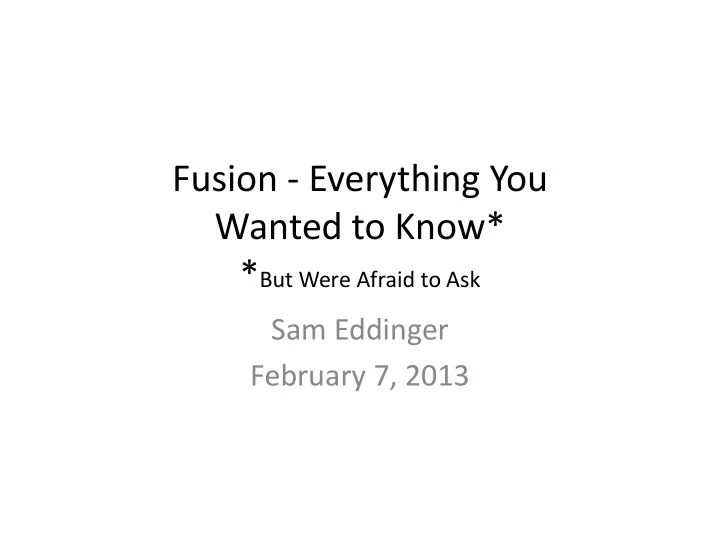

Fusion - Everything You Wanted to Know* * But Were Afraid to Ask Sam Eddinger February 7, 2013
Introduction • Overview – What is Fusion • Current Techniques for Scalable Fusion – Toroidal Confinement Fusion (TOKAMAK) • Also known as Magnetic Confinement Fusion (MCF) – Inertial Confinement Fusion (ICF) • Current Technical Challenges • Future Technical Challenges • My Role in the industry - how ICF targets are created
Predominate Fusion Fuel • Fusion in the sun starts with normal Hydrogen • To maximize energy per reaction, research uses combination of Deuterium and Tritium
What is Fusion • Process of combining two smaller nuclei into a larger nucleus and energy • Energy and byproducts released are predictable – Allows for easy detection of Fusion events
How to Cause Fusion • Requires High Energy to overcome Coulomb Force
How to Cause Fusion (continued)
Similarities Between Fusion and Fission • Nuclear Reaction – Energy Released through converting mass into energy • Fusion/Fission fuel have high energy density – Fusion takes ~ 5X less mass to get same energy as Fission • Fusion/Fission events create excess neutrons – Excess Neutrons cause surrounding material to transmutate and become radioactive • Fusion/Fission events create radioactive material – Tritium for fusion, many byproducts for fission • Significant Control Systems to control both reactions • Both technologies have the capability of breeding fuel
Relative size of Fuel for Power Plants
Differences Between Fusion and Fission • Fission • Fusion • Breaking apart Nucleus • Putting together Nucleus • Fuel Loaded into Core • Fuel Injected into Core • Fuel confined for years • Fuel confined for < 1 second • Performed at Low Temp. • Performed at High Temp. • Neutrons needed for chain • Temperature needed for chain reaction reaction • Removal of Poison to start • Heating needed to start reaction reaction • Reactivity controlled by • Poisons destroy Reactivity poisons (causes instability)
Differences Between Fusion and Fission (continued) • Fission • Fusion • Each nucleus can only • Each nucleus may be able to fission once fuse more than once • Limited fuel resource • Unlimited fuel resource • Radioactive waste for > • Radioactive waste for ~ 100 1000 years years • Decay Heat • No Decay Heat • Many safety systems and • Limited safety systems and analyses required analyses required • Man made technology • Energy source of the universe • Operational technology • Always 50 years in the future
Element Selection Fusion Fission
Three Main Design Considerations In Fusion Technologies • Fuel Temperature – Defined by choice of Fusion Isotopes – Higher temperature is harder to obtain and maintain • Fuel confinement time – Defined by technology • MCF requires high confinement time (design challenge) • ICF has low confinement time • Fuel Density – Defined by technology • MCF has low fuel density • ICF requires high fuel density (design challenge)
Fusion Temperature vs. Reaction Rate • Reaction Rate is inversely proportional to confinement time and density • Optimizing the temperature of the fuel will minimize the confinement time and/or density needed
Fusion Isotope Selection
Current Techniques for Scalable Fusion
Magnetic Confinement • Two different magnetic Fields used – Toroidal • Used to confine the plasma – Poloidal • Keeps the plasma away from the walls
Inside the Magnetic Confinement Core
Magnetic Confinement Diagnostics
Inertial Confinement
Inertial Confinement • Two predominate methods to implode target – Direct drive • Lasers directly strike target – Symmetrical implosion issues – Indirect drive • Lasers strike can called a Hohlraum – Laser energy converted to x-rays – Requires higher laser energy output
National Ignition Facility (NIF)
NIF Internals
NIF Target Chamber
Inside the Inertial Confinement Core
NIF Target holder
NIF Target
Fusion Capsule Contained in NIF target
Current Challenges in MCF and ICF • Neither technology can reach Breakeven (Q=1) – Defined as Ratio of Fusion power produced / Power needed to keep the plasma in steady state • Caused by insufficient number of fusion reactions prior to the system becoming unstable – Significant technical challenges to meet the requirement for both technologies • Scientists continue to underestimate the interaction of hot dense particles – Q ≈20 needed for commercialization – Q= ∞ for the sun
Future Challenges in MCF and ICF • Fusion creates high energy neutrons – Expected to be 100X the flux of a fission reactor – Difficult to convert Neutron energy into power – High Neutron flux causes material embrittlement and radioactivity – Difficult to test materials at these conditions • Fusion requires high temperatures – Temperature cycling causes fatigue – Easy to damage system if plasma becomes instable
Future Challenges in MCF • No easy way to convert heat into energy • Difficult to constrain plasma for sufficient times to generate power – Helium and other atoms take the energy without causing additional Fusion events • Difficult to remove these poisons without affecting plasma – Currently external power is needed to heat plasma – Continuous injection of Fusion material for self sustaining reaction • Reducing energy into magnets – Superconductivity requires low temperature for magnets
Future Challenges in ICF • Require six target implosions a second for sufficient power – Difficult to cool mirrors – Difficult to inject repeatably at this rate • Impossible to have self sustaining reaction – Need to shoot each target independently to generate Fusion energy
Schematic of a Commercial ICF plant
Recommend
More recommend